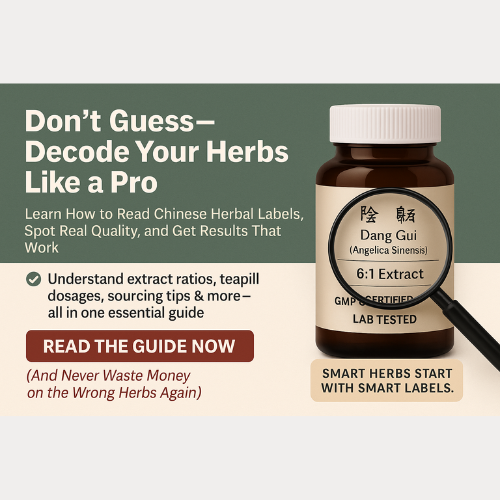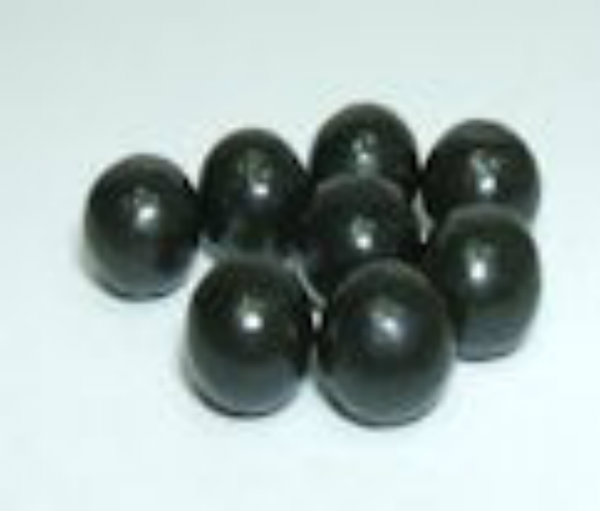How to Read a Chinese Herb Label (and Avoid Wasting Your Money)
Decode teapills, extract powders, and ingredient lists with confidence—no Chinese degree required.
Confused by Chinese herb packaging? Learn how to read teapill labels, understand extract ratios, and spot red flags before you buy. This guide breaks down everything you need to know to choose the right product—and avoid wasting money on the wrong one.
Ever stared at a bottle of Chinese herbs and thought,
“What does 6:1 extract mean?”
“Is Huang Qin the same as Baikal Skullcap?”
“How many of these little pills am I supposed to take?”
You’re not alone.
Reading a Chinese herb label shouldn’t feel like decoding ancient scrolls. But unfortunately, most herb packaging is filled with unfamiliar names, unclear dosing, and vague quality claims. And that’s how good people end up with weak products, misused herbs, or formulas that just don’t work.
Let’s fix that.
This article will show you exactly how to read a Chinese herb label like a pro—so you can shop smart, dose right, and get results.

Section 1: The 5 Things Every Chinese Herb Label Should Tell You
Here’s what to look for every time you pick up a bottle, bag, or jar:
| Label Element | Why It Matters |
|---|---|
| Pinyin and English Names | You need to know what herb you’re taking and how it’s referred to in both Chinese and Western contexts. |
| Extract Ratio (e.g. 6:1) | Tells you the strength of the extract and how much raw herb it represents. |
| Recommended Dosage | Chinese herbs have different standards than Western supplements. |
| Sourcing & Testing Info | Look for GMP certification, lab testing, and country of origin. |
| Form (teapill, powder, decoction) | Each form has different potency and ideal use cases. |
Section 2: Understanding Herb Names – Pinyin vs. English
Here’s why one herb may have 3 different names:
-
Pinyin: The Romanized spelling of the Mandarin name (e.g., Dang Gui)
-
Botanical Latin: Used in scientific references (e.g., Angelica sinensis)
-
English Name: What most Westerners recognize (e.g., Chinese Angelica Root)
Example:
| Pinyin | English Name | Botanical |
|---|---|---|
| Huang Qin | Baikal Skullcap Root | Scutellaria baicalensis |
| Bai Zhu | White Atractylodes Rhizome | Atractylodes macrocephala |
| Gan Cao | Licorice Root | Glycyrrhiza uralensis |
Knowing these helps you:
-
Avoid buying the wrong herb
-
Research correct uses
-
Cross-check ingredients in formulas
Section 3: What Does a 6:1 Extract Ratio Mean?
Let’s decode this with an example:
6:1 Extract = 6 parts raw herb were used to make 1 part concentrated powder
-
It’s more potent than raw herb.
-
You need less powder to get the same effect as a decoction.
-
Quality varies by brand and process.
Extract Ratio Tips:
-
Higher ratio ≠ always better. A poorly extracted 10:1 is weaker than a well-made 5:1.
-
Look for brands that use GMP facilities and offer COAs (Certificates of Analysis).
-
Don’t mix extract powders in cold smoothies—they absorb better in warm water.
 Section 4: How to Read Teapill Instructions
Section 4: How to Read Teapill Instructions
Teapills are one of the most common—and misunderstood—forms of Chinese medicine.
Here’s what to know:
| Element | What to Look For |
|---|---|
| Serving Size | Usually 8–12 pills per dose |
| Frequency | 2–3 times daily is typical |
| Duration | Most formulas are taken for 1–3 weeks at a time, depending on the issue |
| Cautions | Pregnancy warnings, heat/cold constitution incompatibilities |
⚠️ Common Mistake:
Taking 2 pills once a day and expecting results.
Chinese teapills are meant to be taken consistently and in larger quantities than Western pills.
Teapills are about the size of a pea.
Section 5: Where It’s From (And Why That Matters)
Chinese herbs are powerful—but only when grown, harvested, and processed correctly.
Here’s what to look for on the label or product description:
-
GMP-Certified Manufacturer
-
Lab Testing for Heavy Metals, Pesticides, and Identity
-
Sourced from DaoDi Regions (traditional high-quality growing zones in China)
Red Flags:
? No sourcing info
? "Proprietary blend" without full ingredient list
? No extract ratio or dosage instructions
Indepth Article on Purity Of Products / Certificate of Analysis
Section 6: Bonus – Label Breakdown Example
Here’s how to read this sample label:
Product Name: Calm Spirit Teapills (Gan Mai Da Zao Wan)
-
Pinyin: Gan Mai Da Zao
-
English Function: Nourishes Heart, Calms the Shen
-
Dose: 8 teapills, 3x daily
-
Extract Ratio: 5:1
-
Sourcing: GMP Certified, Tested in USA
-
Cautions: Not for cold-type depression or excessive dampness
Now you know this product is:
-
Targeted for Shen disturbance (emotional restlessness, anxiety)
-
Potent at a moderate extract strength
-
Safe and lab-tested
Final Thoughts: Know Before You Swallow
Chinese herbs are deeply effective—but only when you understand what you're taking, how much, and why.
Here’s your new mantra:
"If the label doesn’t tell me enough, I won’t buy it."
At 1st Chinese Herbs, we make label reading easy:
-
Pinyin + English names? ✅
-
Dosage and extract strength? ✅
-
COAs and sourcing transparency? ✅
-
Educational support? ✅
No guessing. No hype. Just results.
Browse our collection of lab-tested, clearly labeled, practitioner-trusted products at 1stChineseHerbs.com.
Your body will thank you—and your wallet won’t regret it.
1. Plant‑to‑Extract / Extract Ratio Labeling
-
“Understanding plant to extract ratios in botanical extracts” clarifies that Plant-to-Extract (or Drug-to-Extract) ratios reflect how much raw plant material is used to produce extracts—but don’t convey potency or solvent composition—which can mislead dosage expectations pubmed.ncbi.nlm.nih.gov+15pubmed.ncbi.nlm.nih.gov+15pubmed.ncbi.nlm.nih.gov+15pmc.ncbi.nlm.nih.gov.
2. Enhanced Bioavailability via Modern Formulations
-
A study on a Solid Self‑Microemulsifying Drug Delivery System (S‑SMEDDS) with Salvia miltiorrhiza extracts found 60–80 % of active constituents (e.g., tanshinones and salvianolic acids) were released within 20 minutes in vitro, showing higher oral absorption than standard suspensions pubmed.ncbi.nlm.nih.gov+1pubmed.ncbi.nlm.nih.gov+1.
-
Another review on piperine (from Piper longum) showed it can boost oral bioavailability of compounds like curcumin by 30–200 %, and in some cases, up to tenfold pmc.ncbi.nlm.nih.gov.
3. Pharmacokinetics & Herb–Herb/Drug Interactions
-
A recent review examines the pharmacokinetic mechanisms and interaction potential between herbs or herbs and drugs when used in Chinese herbal formulas pubmed.ncbi.nlm.nih.gov+1pmc.ncbi.nlm.nih.gov+1.
4. Clinical Efficacy & Safety Trials
Here are several randomized controlled trials (RCTs) and systematic reviews demonstrating efficacy and safety:
-
Banxia Houpo/Ding Chuan hybrid extract (BDT1) significantly reduced pneumonia hospitalization (10 % vs. 34.2%) in older adults over 12 weeks; no hepatotoxicity/nephrotoxicity observed pubmed.ncbi.nlm.nih.gov+3pubmed.ncbi.nlm.nih.gov+3pubmed.ncbi.nlm.nih.gov+3pubmed.ncbi.nlm.nih.gov.
-
Chinese herbal medicine in COPD: Meta-analysis showed CHM plus usual care improved respiratory symptoms, quality of life, and reduced exacerbations, with a favorable safety profile pubmed.ncbi.nlm.nih.gov+2pubmed.ncbi.nlm.nih.gov+2pubmed.ncbi.nlm.nih.gov+2.
-
Infertility treatment: CHM roughly doubled pregnancy likelihood (OR 3.5) over 4 months compared to Western drugs or IVF (60 % vs. 32 %) pubmed.ncbi.nlm.nih.gov.
-
Acute gouty arthritis: CHM showed modest but significant improvements over standard treatment (RR 1.11) pubmed.ncbi.nlm.nih.gov.
-
Recurrent aphthous stomatitis: Zhibai Dihuang Pill plus Western meds lowered recurrence (RR 0.24) and pain compared to Western meds alone pubmed.ncbi.nlm.nih.gov+5pubmed.ncbi.nlm.nih.gov+5pubmed.ncbi.nlm.nih.gov+5.
-
Rheumatoid Arthritis (RA): Integrative treatment combining TCM and Western medicine yielded effective and safe outcomes pubmed.ncbi.nlm.nih.gov+1mayway.com+1.
-
Benign Prostatic Hyperplasia (BPH): CHM outperformed Western medications in quality-of-life and prostate volume reduction, with similar or fewer adverse events en.wikipedia.org+5pubmed.ncbi.nlm.nih.gov+5pubmed.ncbi.nlm.nih.gov+5.
